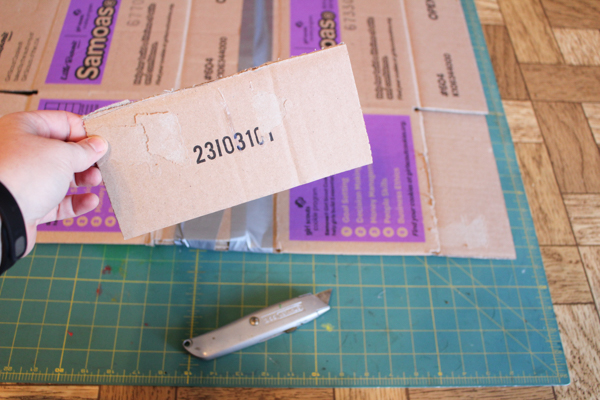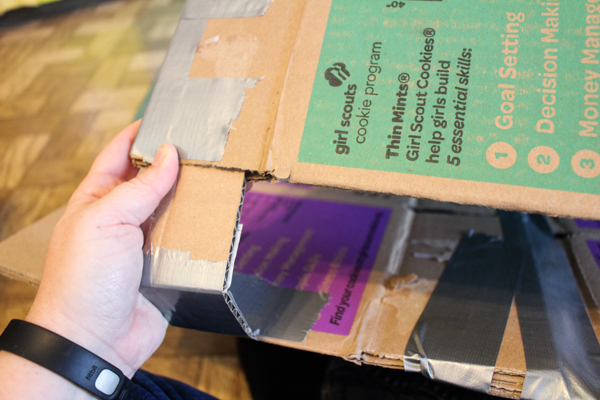.jpg)
My Girl Scout troop's Folk Arts IPP meeting is a wrap!
Alas, for I did not meet my goal. At one point I asked the troop to start cleaning up after soapmaking while I went to see if the beeswax and coconut oil were completely melted for candlemaking. I swear I was gone for approximately fifteen seconds, but I came back into the room to the following:
KID #1: "[Name Redacted] hurt herself."
KID #2: "I see blood."
NAME REDACTED (bleeding profusely from the head and dripping blood onto the floor) begins to fall over.
KID #3: "I don't feel well."
And scene!
I also can't say that my first aid administration went perfectly, because how do you situate a kid when her head is bleeding so needs to be elevated, but she's also losing consciousness so her feet need to be elevated? Do you just prop her up like a little pretzel with her butt on the ground and her head and feet jacked up? Keeping her conscious felt pretty important so my co-leader and I put her feet up high and her head just on a pillow, but I'll clearly have to ask more scenario-specific questions at my next re-certification.
But the good news is that the injury was actually just a side quest, and nobody actually got injured during either the cold-process soapmaking (during which the kids wore long sleeves, gloves, and face shields) or the poured container candlemaking (which, tbh, was pretty chaotic, so I think we just got lucky).
We did get a chance to press flowers in the microwave, but our first aid practicum used the time previously intended for decoupaging our flowers, so we'll save that for another meeting.
But until then, I was left with SO MANY flowers that I'd already pressed to give the kids plenty to work with, and since I'm uninterested in figuring out how to safely keep pressed flowers in my already overburdened craft supplies storage, later that week I snookered my own kids into helping me decoupage them, in the process further refining my almost perfect technique.
And now that technique IS perfect!!!
My old method for making pressed flower bookmarks came from this tutorial, which came from a magazine article, which came from a vintage Boy Scout manual. All of them called for decoupaging the flowers first onto waxed paper, and then using the method of your choice to adhere the waxed paper to a more structured paper.
My incredible innovation is just to... ditch the waxed paper. Decoupage the pressed flowers directly to the material of your choice, saving yourself a step and, I think, improving the overall look of the finished product. I also changed out the glue to one that dries stiffer, which I think makes the work sturdier and requires fewer top coats.
To test out this innovation, the kids and I made SOOOO many greeting cards! Will has a ton of thank-you notes to write and we're out of nice cards, so this was a good chance to replenish our stash.
To decoupage your own pressed flower greeting cards, you will need the following:
- pressed flowers. I do have a new and improved microwave pressed flowers tutorial coming up, but until then, my original microwave pressed flowers tutorial does work well.
- backing material of your choice, ideally one with structure. I used this hemp watercolor paper and this Strathmore watercolor paper, and of the two I preferred the hemp paper. I really liked how the off-white color and visible fibers add to the overall look.
- single ply of the cheapest disposable tissues you can find. If your tissues are multi-ply, separate them into the individual sheets.
- clear school glue. I used Elmer's clear school glue leftover from Syd's slime-making phase.
- paintbrush. A stiff paintbrush works better than a soft one.
- matte medium. I use this Liquitex matte medium. It's weirdly expensive, so I think you could play around with cheaper sealants, too.
1. Cut and fold paper to make greeting cards.
Will and I did this with a guillotine paper cutter, but you could do it by hand. If you've got 8"x12" pages, you can make two 4"x6" cards from each page. We made some that hinged at the top, and some that hinged on the side, mostly because we weren't paying attention to what we were doing.
2. Arrange pressed flowers on the greeting card front.
.jpg) |
| Queen Anne's Lace |
This part is really fun! It was definitely assisted by the huge stash of flowers I'd already collected and pressed. Seriously, I took trips to the local parks to take little snippy-snips of the wildflowers growing there, waded around vacant lots next to strip malls, and sacrificed many of the lovelies from my garden.
.jpg) |
| Rose of Sharon |
But having such a large selection of flowers to choose from made that completely worth it!
.jpg)
3. Use clear school glue to paint a single ply of tissue paper over the entire card front.
Gently set the tissue over the card front. Use your non-dominant hand to gently hold the tissue and the flowers in place, and with your dominant hand dip the paintbrush into clear school glue, allowing a generous coat of glue to remain on the brush.
Start with the center of one flower, and gently paint glue onto the tissue paper covering it. The glue will seep through the tissue paper onto the flower, rendering the tissue paper translucent:
Use the stiffness of the brush to coax the tissue paper into all the little nooks and creases of the pressed flower, aiming for maximum adhesion of the tissue paper to the flower and card.
.jpg) |
| Rose of Sharon and fern |
The tissue paper will make lots of wrinkles when you glue it to the card, which is fine. What you don't want are air pockets between the flowers and tissue paper, because those will stay visible in the final product.
.jpg) |
| Queen Anne's Lace |
Work your way across the surface until the entire card front is covered. Leave the excess tissue paper in place until the whole thing is dry, which should take about a day.
.jpg) |
| Rose of Sharon |
4. Trim the tissue paper and add embellishments.
Trim the excess tissue paper from the greeting card fronts. If possible, it is highly desirable to have the assistance of both a teenager and a cat for this step:
You can do anything that you want regarding embellishments, but I entertained myself by finding fun phrases and conversations from this vintage Spanish textbook that I found in a Little Free Library once upon a time:
Although some is random--
--some, I think, is quite apt!
.jpg)
Dab a little more clear school glue onto the back of each embellishment to place it, then use the pad of your finger to thickly coat the entire greeting card front in matte medium.
.jpg) |
| Chamomile |
Let dry.
You can add additional coats of matte medium, which I did for a couple of cards but ultimately decided that it's unnecessary, especially because matte medium is so expensive!
And here are some of our finished cards!
.jpg) |
| It's that Queen Anne's Lace from Step 2! |
.jpg) |
| Chamomile from Step 4 |
.jpg) |
| Fern |
.jpg) |
| Rose of Sharon from Step 2 |
I still need to make matching envelopes for these cards, but then they'll be ready for thank-yous!
.jpg)
.jpg)
.jpg)
.jpg)
.jpg)
.jpg)
.jpg)
.jpg)
.jpg)
.jpg)
.jpg)
.jpg)
.jpg)
.jpg)
.jpg)
.jpg)
.jpg)
.jpg)
.jpg)
.jpg)
.jpg)
.jpg)
.jpg)
.jpg)
.jpg)
.jpg)
.jpg)
.jpg)
.jpg)























